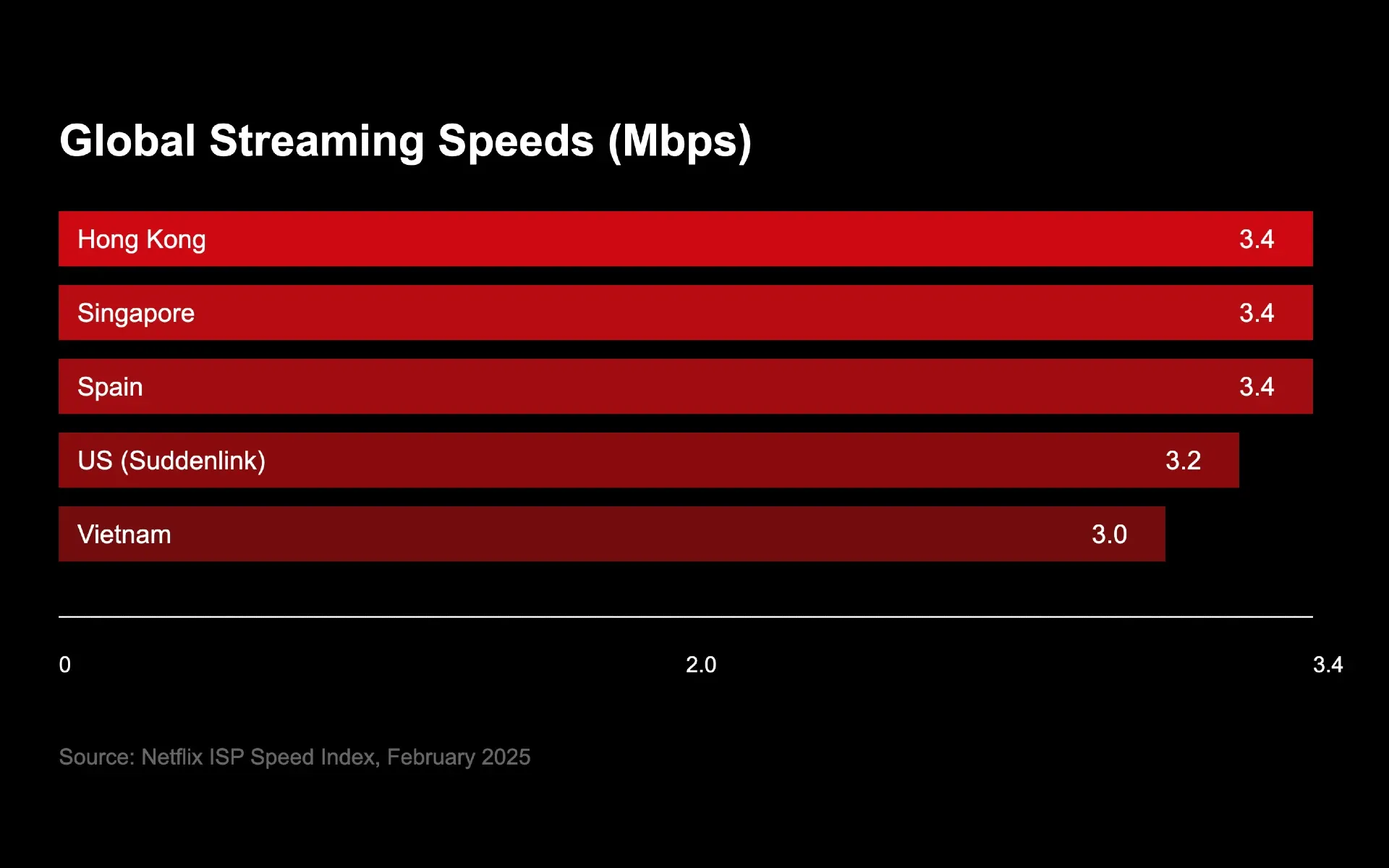These 3 countries dominate Netflix speeds while US providers lag behind
Latest streaming data reveals surprising gaps between global regions, with unexpected leaders topping worldwide rankings.

Global internet streaming performance data released on February 10, 2025, indicates substantial regional variations in service delivery across major markets. The latest measurements show that Asian markets continue to maintain their position at the top of global rankings, while several European providers have recorded notable improvements.
According to the Netflix ISP Speed Index, Hong Kong, Singapore, and Spain achieved the highest performance tier with average speeds of 3.4 Mbps in December 2024. This technical benchmark represents optimal streaming conditions during peak viewing hours, as measured across multiple service providers.
The data reveals significant technological disparities between regions. In Southeast Asia, Vietnamese provider Viettel implemented infrastructure improvements that resulted in a 0.4 Mbps speed increase, elevating their performance from 2.6 to 3.0 Mbps. This technical advancement marks the most substantial improvement recorded in the latest measurement period.
North American markets demonstrated mixed results. Canadian providers Eastlink's fiber and DSL services both registered gains, with their high-speed fiber service reaching 3.4 Mbps, while their DSL infrastructure achieved 2.6 Mbps. In the United States, regional providers Windstream and Suddenlink both improved their technical capabilities, achieving speeds of 3.2 Mbps and 3.4 Mbps respectively.
European markets showed consistent technical progress. Danish providers demonstrated particular strength, with three major ISPs - Hiper, Waoo (Fibia), and YouSee - Cable - all achieving the benchmark speed of 3.4 Mbps. Similar technical improvements were documented in Luxembourg, Norway, Spain, and Switzerland, where providers Eltrona, NTE, Telia, R, and Wingo reached equivalent performance levels.
The measurements indicate that 87% of global providers maintained stable performance metrics compared to the previous month. However, 8% of providers experienced a decrease of 0.2 Mbps, while 5% achieved improvements ranging between 0.2 and 0.4 Mbps.
South American markets presented contrasting results. Brazilian provider Oi Internet increased its performance to 2.2 Mbps, while Paraguay's Copaco reached 1.8 Mbps. However, aggregate national measurements showed that Peru and Uruguay experienced overall declines, with average speeds dropping from 3.2 to 3.0 Mbps.
African markets demonstrated progress in technical capabilities. South African providers recorded notable improvements, with WebAfrica reaching 3.2 Mbps and Telkom achieving 2.8 Mbps. These advancements indicate ongoing infrastructure development in the region.
The technical measurements specifically evaluate prime-time streaming performance, utilizing standardized metrics across all markets. This methodology focuses on consistent data collection during peak usage periods, providing comparable performance indicators across different regions and technologies.
Historical data from the past quarter indicates a gradual improvement in global average speeds, though progress remains uneven across regions. The measurements demonstrate that fiber-optic infrastructure consistently delivers superior performance compared to traditional copper-based technologies.
The latest data also highlights the technical challenges facing developing markets, where infrastructure limitations continue to impact service delivery. However, the measurements indicate that targeted infrastructure investments can yield significant improvements in performance metrics, as demonstrated by the Vietnamese market's recent advances.
This comprehensive dataset provides insights into global internet infrastructure capabilities, reflecting both technological advancements and persistent challenges across different markets. The measurements underscore the critical role of infrastructure investment in achieving consistent high-speed connectivity, particularly during peak usage periods.
The technical benchmarking methodology employed in these measurements focuses specifically on streaming performance during prime-time hours, providing standardized metrics for comparing service quality across different markets and technologies. This approach enables objective evaluation of infrastructure capabilities while accounting for variations in local network conditions.

